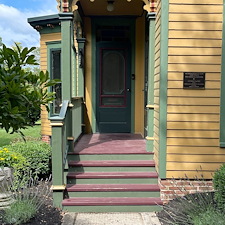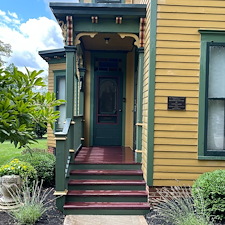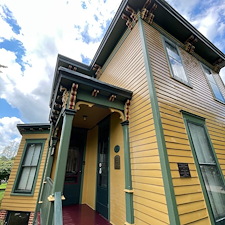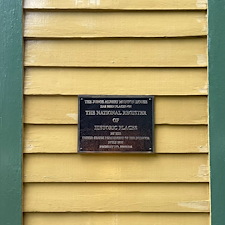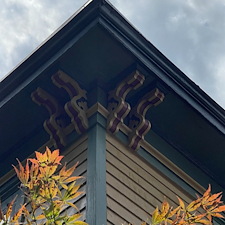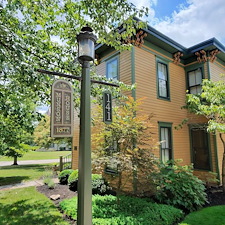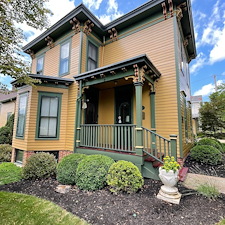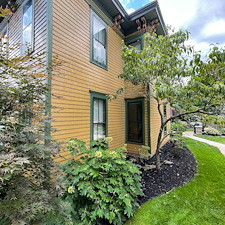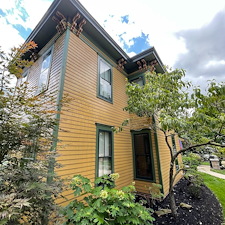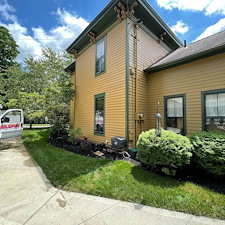“The Benefits of Routine Soft Washing for Century Homes like the Munson House in Medina, Ohio we recently cleaned!”
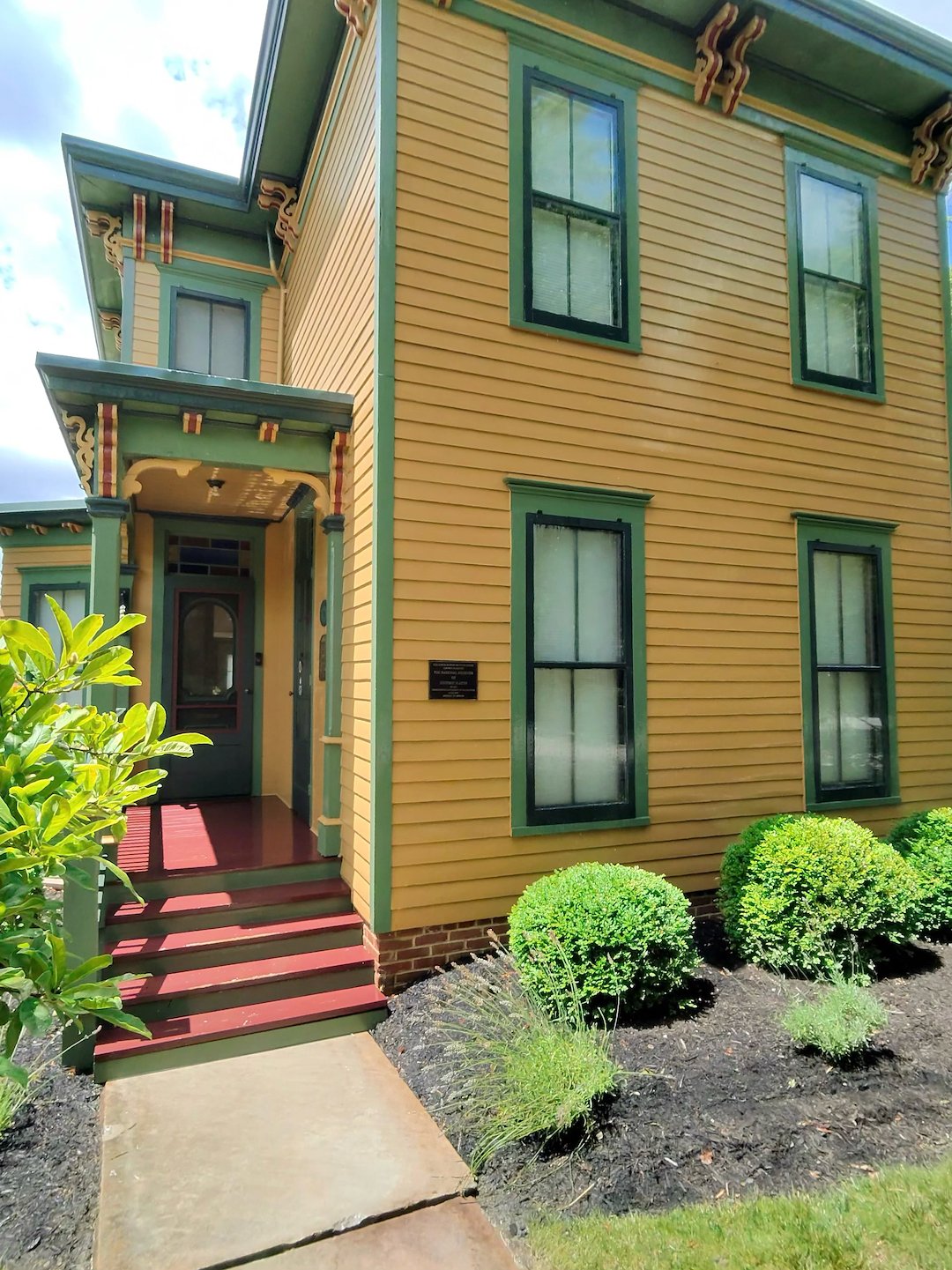
Owning a century home, such as the historic Munson House in Medina, is both a privilege and a responsibility. These architectural treasures carry with them stories of the past and require careful maintenance to preserve their charm for future generations. One of the most effective ways to maintain the exterior beauty and integrity of such homes is through routine soft washing. This gentle yet powerful cleaning method offers numerous benefits that are crucial for the upkeep of historic properties.
Understanding Soft Washing
Soft washing is a cleaning technique that uses a low-pressure water spray combined with specialized solutions to remove dirt, algae, mold, and other contaminants from surfaces. Unlike traditional residential pressure washing, which uses high-pressure water that can damage delicate surfaces, soft washing is ideal for the older, more sensitive materials found in century homes.
Benefits of Soft Washing for Century Homes
1. Preservation of Historical Integrity
The Munson House, like many century homes, is constructed with materials that may not withstand the harshness of modern cleaning techniques. Soft washing ensures that these materials are preserved, maintaining the home's historical integrity. By using gentle cleaning solutions, soft washing effectively removes contaminants without stripping paint or damaging wood, brick, or stone surfaces.
2. Enhanced Curb Appeal
First impressions matter, especially when it comes to historic homes that often serve as landmarks in their communities. Routine soft washing keeps the Munson House looking its best by removing unsightly stains and discoloration that can develop over time. A clean exterior enhances curb appeal and reflects the care and pride of its owners.
3. Prevention of Damage
Mold, mildew, algae, and lichen are not just unsightly; they can cause significant damage to the exterior surfaces of a home. These organisms feed on organic materials, leading to deterioration. Regular soft washing prevents the buildup of these harmful substances, safeguarding the structural integrity of the Munson House and other century homes.
4. Cost-Effective Maintenance
Routine maintenance is always more cost-effective than major repairs. By regularly soft washing their homes, owners can prevent the need for expensive restoration work caused by neglect and environmental damage. This proactive approach helps maintain the property's value and extends the lifespan of its materials.
5. Healthier Living Environment
Mold and mildew are not only damaging to a home's structure but can also pose health risks to its inhabitants. Soft washing removes these potential allergens, contributing to a healthier living environment for the residents of the Munson House and similar century homes. By reducing the presence of mold spores and other allergens, homeowners can ensure that their indoor air quality remains high, promoting the well-being of those who live there.
Choosing the Right Soft Washing Professional
When it comes to maintaining a historic property like the Munson House, it's essential to choose a professional soft washing service with experience in handling century homes. Look for companies that specialize in historic preservation and use eco-friendly cleaning solutions that are safe for delicate surfaces. A knowledgeable professional will tailor their approach to suit the unique needs of your home, ensuring that its beauty and structural integrity are preserved.
Conclusion
Routine soft washing is an invaluable practice for maintaining the beauty and value of century homes like the Munson House in Medina. By opting for this gentle yet effective cleaning method, homeowners can protect their historic properties from damage, enhance curb appeal, and create a healthier living environment. With the right care and attention, century homes can continue to stand as proud symbols of a rich architectural heritage, cherished by generations to come.
For residents of Medina, Hudson, Akron, Oh and beyond who are fortunate enough to own a piece of history, embracing routine soft washing is a commitment to preserving the past while enjoying a well-maintained and visually stunning home.
Washing a historical or century home requires special care to preserve its integrity and architectural features. Here’s a general process to follow:
1. Assessment and Planning:
- Evaluate the condition of the home’s exterior, identifying materials (wood, brick, stone, etc.) and any areas needing special attention.
- Check for any existing damage, such as loose or missing mortar, cracked paint, or damaged wood, and plan repairs if necessary.
2. Choosing the Right Cleaning Method:
- Soft Washing: Use for delicate surfaces; involves low-pressure water mixed with cleaning solutions.
- Pressure Washing: Suitable for more durable surfaces but should be used with caution to avoid damage.
- Hand Cleaning: For intricate details and sensitive areas, use gentle brushes and appropriate cleaning agents.
3. Selecting Cleaning Agents:
- Use mild, non-abrasive cleaners. Avoid harsh chemicals that could damage historical materials.
- Test cleaning solutions on a small, inconspicuous area to ensure no adverse reactions. Often the paint on historic buildings will contain organic compounds in the paint to make the pigment in the color. Sherwin Williams paints have been widely used and recognized as the best choice for historical and century homes.
4. Preparation:
- Protect landscaping, windows, and doors with plastic sheeting or tarps.
- Ensure all windows, doors, and other openings are sealed to prevent water intrusion.
5. Cleaning Process:
- Start from the bottom and work up to prevent streaks and ensure thorough rinsing.
- Use appropriate techniques for each material:
- Wood: Soft wash or hand clean with mild detergent.
- Brick/Stone: Low-pressure wash to avoid eroding the surface or mortar.
- Stucco: Gentle wash with minimal pressure.
- Rinse thoroughly to remove all cleaning agents.
6. Addressing Problem Areas:
- Mold or Mildew: Use specialized organic cleaners that don’t contain sodium hypochlorite or bleach designed for mold and mildew removal.
- Stains: Address with specific treatments based on the stain type and surface material.
7. Final Inspection and Touch-Ups:
- Check the entire exterior for missed spots or areas needing additional cleaning.
- Perform any necessary touch-ups or repairs, such as repainting or re-pointing mortar.
8. Post-Cleaning Maintenance:
- Establish a regular cleaning schedule to maintain the home’s appearance and prevent future build-up.
- Regularly inspect for signs of wear or damage to address issues promptly.
Throughout the process, it’s crucial to be gentle and considerate of the home’s historical value. Consulting with a professional experienced in cleaning historical homes is often advisable to avoid damaging the property.
Location: Medina, OH
Project Image Gallery

Wash Away The Grime With Our Akron Pressure Washing Experts
Give Us A Call Today!
